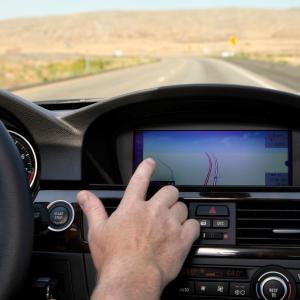Announcements
No announcements yet.
Editor's note:
Humor in advertising is a delicate method of attracting a viewer's/listener's attention to the client's product. Done right, it achieves success. Doing it right means not only engaging the prospect but getting them to remember the product. On a national level who can forget the Budweiser Frogs and Wendy's "Where's the Beef" on television. The VW Bug intro campaign was a great one in print.
Advertising & Marketing Review decided to explore the art of humor in advertising with some locally successful people. We invited Tom Evans, Creative Director at Morey-Evans to talk about humor on radio. The agency is responsible for the Good Times Burger spots. Don Stroh has been successfully creating direct marketing cartoon humor and addresses that issue. David Emrich of Post Modern, approaches the subject from the production standpoint. Enjoy their comments and learn more on the art of humor in advertising.
What is funny in radio is a question that should be preceded, as when evaluating any creative medium, with another question.
Why be funny in radio?
By Tom Evans, Morey-Evans Advertising
One very good reason is that two other common approaches, direct information (announcers) and musical entertainment (jingles and the like), are both so inherently a part of the existing programming of radio that commercials utilizing those tactics often disappear into the sea of clutter fomented by the medium itself.
What real chance does a rock-n-roll beer commercial have to stand out between a gazillion-selling cut from The Rolling Stones and a gazillion-selling cut from Big Head Todd?
Humor, on the other hand, is rare. So rare, it stands out. It engages completely. And, (pay attention because this is really important) as long as the laughter it generates is relevant to your intended audience and messaging strategy, humor has undeniable power in the radio medium.
While true humor is rare, attempts at being funny, unfortunately, are not. It's kind of like trying to jump over the net after a tennis match. If you make it, you're golden. If you don't, you're gonna catch a foot and flip on your head and look like an idiot (funny as that may be).
In other words, as much as funny radio is effective and appreciated by listeners, unfunny radio that's trying to be funny is, well, annoying as hell.
An undeniable tenet of broadcast writing was shared with me once by a tipsy creative director during a three-martini lunch (this wasn't recently). "A funny script is an accomplishment, but a funny commercial is a miracle."
I'll give you an example. I remember a spot a few years ago written by John Rabuse, a freelance radio writer in Minneapolis. It featured a guy talking on the phone to a nurse at an urgent care facility. The guy was trying to explain to the nurse that he needed medical help because a lobster had clamped onto his tongue. The actor read his half of the dialogue while literally holding his tongue out of this mouth. (Try it.)
I never saw one person listen to that spot without laughing out loud. Not just a smile, an all-out laugh. Granted, the technique was about as high-brow as The Three Stooges playing polo on Shetland ponies. Nonetheless, when John sat down to think about that job, he knew the minute it hit him that a guy talking while holding his tongue would make people laugh.
Of course, speaking to all the writers out there, the hilariously funny hold-your-tongue-while-you-talk idea has now been taken.
But a lot of other ideas haven't. Ideas that leverage the absolute superiority of radio to generate humor.
You can be funny in print, outdoor, television and, so I've heard, direct mail. But when it comes to really spinning out a laugh, radio offers the most tools of any medium. Character, timing, disconnection from reality, timing, dialogue, slapstick, timing, grandiosity, minimalism, timing... you name it, radio lets you leverage it (just remember humor almost always relies on timing).
You often get a full 60 seconds to pull it off, too. Which, in a world that's seeing more and more 15-second TV spots, is a real luxury.
My opinion: Print may be the mother medium for advertising, but radio is the mother medium for humor in advertising.
Tom Evans is Creative Director of Morey Evans Advertising, creators of the award-winning "We're Gonna Be Big" campaign for Good Times. While he no longer writes any Good Times radio advertising personally, he does still on occasion stick in a really funny part.
The Serious Side of Humor in Direct Marketing
by Don Stroh
How would you like to increase your direct mail conversion rates by 25, 200 or even 1,100 percentage points? All it takes is the kind of courage a man displays entering the reddish-purple retail womb of Victoria's Secret for the first time to buy an undergarment for his woman.
After 30 years in the ad business, I've often seen the look in a client's eyes when the creative director says, "Maybe we should try a humorous approach." It's like a badger began eating the Ann Taylor pumps off the client's feet beneath the placid surface of the conference room table. "Humor?" she says. "There's nothing funny about our business!"<There's nothing funny about war, either. Just ask Joseph Heller, or read Catch-22.
Why does using humor terrify us so? Perhaps it's the fear of falling flat, of "dying on stage." No one wants to be "not funny," so using humor feels as risky as roller-blading in a tutu down Denver's 16th Street mall.
But the other side of risk is opportunity (lights, camera, action!), as in the aforementioned conversion rate increases I've experienced in direct marketing campaigns for clients who braved the use of a humorous approach.
Is there something logical about why everyone seems to respond to humor? No! That's the point. People respond to humor with their emotions, not with their reason, so as a marketer you can slip past their left-brained defenses and launch a guerilla assault on where they really live and experience life. Doing so requires a little (ugh!) discipline, however.
Think of anything you've found funny and you'll discover a key element of humor-surprise. A man walking down the sidewalk slips on a banana peel, or your client says "My son just took Driver's Edge," and you can hardly contain your laughter.
But to serve the interests of your marketing program, the surprise must be relevant to what you want to sell-to your product or service or company. Relevant humor is an attention-getter that draws your prospect closer. It's a whisper in the ear that says "I like the butterfly tattoo on your buttocks because I've got moose antlers tattooed on my knee." It's an invitation to come out and play, which in a business relationship is surprising in itself.
Are there rules to using humor in direct marketing? Is there life after death? You decide, but consider the following 10 dos and don'ts as guidelines:
1. Don't over-analyze a humorous idea. It's funny, or it's not. As Mark Twain said, "Trying to figure out why something is funny is like dissecting a frog. You'll come up with answers, but the frog always dies."
2. Don't use humor for its own sake. Make it relevant to your objective.
3. Don't use humor to deceive or tell a lie. It's a scientific fact that humor intensifies positive physical and psychological reactions; deceit will undermine these good feelings and supplant them with anger and resentment.
4. Do use humor to entertain. People love to be entertained. (What do you do in your free time?)
5. Do use humor to be thought-provoking, but not offensive.
6. Do test humorous concepts, not techniques. Slapstick, irony and word play are techniques, but what is the idea you want to convey?
7. Do let your reader/listener/viewer experience the joy of "getting it." You'll make a friend.
8. Do engage the imagination of your customers. Theirs may be even bigger than yours.
9. Do the homework on your customer, and I don't necessarily mean formal research. A renowned copywriter from the early days of advertising called research "putting on my hat and going out to talk to people." Humor comes from knowing your audience inside-out.
10. Don't forget that rules are meant to be broken. The best humor comes from the edge, where there are no rules.
Finally, a word of caution. Humor may be addictive. Scientists tell us that humor blocks stress hormones, stimulates endorphins or other chemical reactions, and produces euphoric effects akin to mood-altering drugs. Use humor wisely. Do not try it at home. Call a professional.
Don Stroh, an erstwhile ad agency art director, is now a demented freelance creative director and humor illustrator. Don has had way too much fun producing humorous direct mail campaigns that have garnered outrageous response rates. "Practically criminal," say his clients. "He should be arrested." He's taken a respite to write this article. Seriously.
Humor in Advertising from the Production Side
By David Emrich
It is hard to stand out from the crowd in advertising. There is such a cacophony of sights and sounds on television and radio to compete against. Comedy is perhaps the best way to be memorable to an audience. People definitely talk more about funny spots than they do call-to-action or image spots.
For the work Post Modern does, we have to think differently depending on whether we are editing for comedy or other genres. All genres depend on timing and pacing, yet the pacing decisions for comedy are the most critical: how much time does it take to register a joke? This is one reason that test screenings are used so extensively for features and sitcoms.
There is also a difference between radio and television comedy. Visual humor can be developed much quicker than dialog-driven humor. You can see funny faster than you can hear it. Therefore, in general, pacing becomes even more critical in radio advertising.
Where TV advertising is usually "gag" oriented, radio advertising is "joke" oriented in design. Gags work well in TV, especially given the relatively short 30 second and 15 second lengths of spots.
Radio, on the other hand, is all "joke" oriented. (There aren't a lot of visual gags that work on radio.) Radio also has the advantage of being able to have an element that is traditionally called "Theatre of the Mind." Snappy dialog, sound effects design and character voices all play a part in this style of radio advertising. Locally Fred Arthur was a master of this style in the 70s, 80's and early 90s. Bert Berdis Comedy Radio in LA was a leading figure in this style throughout the same timeframe nationally.
Gag oriented TV ads can be funny and even eye-catching, but they might not always do their job as advertisements. Right now one of my favorite TV spots is one where two guys are attempting to knock a hornet's nest into a garbage can, and everything goes wrong. The voice-over then goes on to identify the advertiser. The first dozen people I asked remembered and liked the spot. However, none of us could remember who/what the spot was advertising. It is almost a generic gag with an interchangeable tag line. It could advertise just about any product or service. We like the spot, but maybe it's not good advertising. Somehow the gag has to be solidly tied to the advertiser.
I always think of comedy as the spark between two incongruous worlds when they come together. The laugh is caused either by the surprise of that spark that was hidden from us, or the anticipation of the spark when the "victims" don't see it coming. I think that advertising rarely has this spark. Most of what we see today in advertising, (and in sitcoms like Seinfeld for instance) is cleverness, not comedy. It may make us laugh, but even if we don't, we see some truth in it. Advertising today is full of this ironic sense of humor and can be quite effective.
But there is not much farce, parody or satire in current spot design Perhaps working with these latter styles is the direction things should take to make our work stand out from the crowd. Just a question: Are these latter forms of comedy what makes Rocky's auto spots work? Is this why the John Hinkenlooper campaign was so successful?
Comedy is more of a state of mind than a genre. We are all funny, smart people, but we may not all be comedy writers. I think somewhere along the way we lost the idea of an audio production company: a company that an agency hires to build onto the agency's ideas, much as film and video production companies do. Or perhaps we need to have more stand-up comedians as writers (and corporate executives for that matter!)
And by the way, I just saw the hornet's nest spot again, the client was Untied Health Care, it didn't want to make me change insurance, but it did make me laugh.
Most Recent Articles
There are no articles yet.
Popular Articles

Giovanna Casotto is next to Ilona Staller(Cicciolina) one of Italy's most popular TV actrices, but she also is an comic art artist, already auteur...
3922 Views

This article is dedicated as a coaching guide to provide Internet users with information on the fast Internet broadband access available today and...
2746 Views

Front end web developers hold a great responsibility to craft pixel-perfect layouts that run properly in all web browsers. Over time this has...
1914 Views

There is no incentive for people to submit their web sites to the web directory, unless it is SEF directory. Why is that so? Really? How one can...
1754 Views

If you've never heard of VoIP, get ready to change the way you think about long-distance phone calls. VoIP, or Voice over Internet Protocol, is a...
1590 Views





